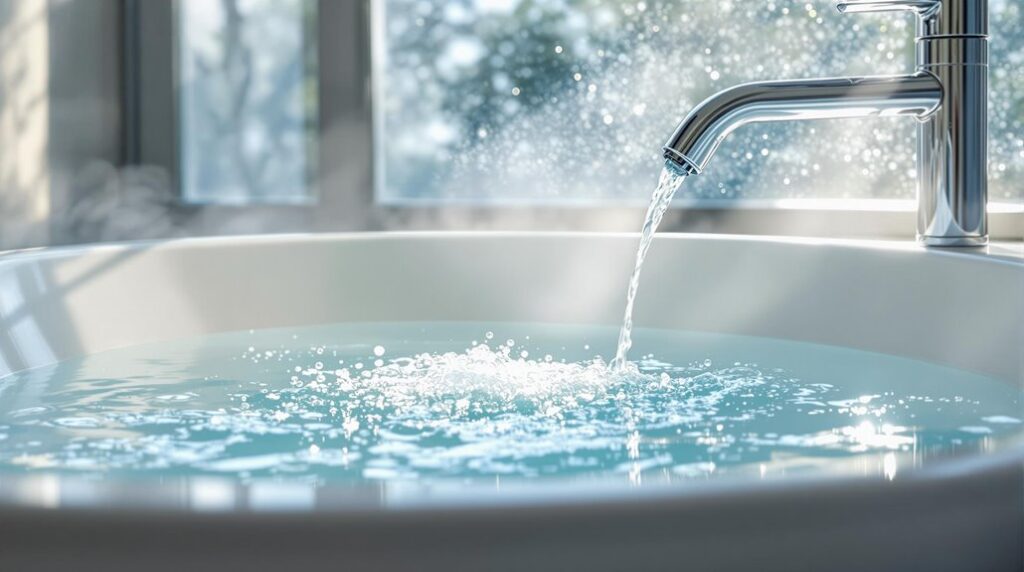I’ve watched countless people make the same costly mistake when bath sealing—they drain the water too early and ruin hours of work. The timing isn’t just about convenience; it’s about whether your seal will hold or fail completely. There’s a specific science behind how long that water needs to stay put, and getting it wrong means starting over from scratch. Let me show you exactly what happens during those vital hours and why patience here saves you frustration later.
Key Takeaways
- Keep water in the tub for the entire 24-48 hour cure period without draining or topping off.
- Cold environments may require up to 72 hours for proper sealant curing before water removal.
- Consistent water weight maintains necessary sealant compression throughout the curing process.
- Test sealant by touch – it should feel rubbery, not tacky, before draining water.
- Standard silicone sealants need minimum 24-48 hours submerged for complete cure and optimal seal strength.
The Critical 5-Minute Rest Period After Processing

When you complete the sealing process, you must allow exactly 5 minutes of uninterrupted rest before handling your restoration. I can’t stress this enough—use a timer to prevent premature movement. Any handling during this critical period introduces structural stress and micro-fractures that’ll compromise your work.
You’ll need shorter periods for incomplete material stabilization, while longer periods just delay your workflow without benefits. During these 5 minutes, I maintain constant temperature at 23°C and keep humidity between 40-60%. Make sure your surface is vibration-free and avoid airflow disturbances. Remember that precision timing directly impacts the need for corrections and potential remakes of your restoration work.
Whether you’re working with acrylic resins completing polymerization or ceramic composites needing thermal equalization, this timing is non-negotiable. Trust the process—your restorations depend on it.
Proper Water Level Maintenance During Post-Processing
Nothing’s more frustrating than ruining a perfect seal because you rushed the water exposure process. I’ve seen countless homeowners skip proper water level maintenance and pay the price with failed seals.
Here’s what you need to know: keep that water in your tub for the entire cure period. Don’t drain it partially or top it off constantly. The consistent weight helps maintain proper sealant compression while it cures.
For standard silicone, I recommend 24-48 hours minimum. Cold bathrooms or low humidity? You’re looking at 72 hours easy. The sealant should feel rubbery, not tacky, when you finally drain that tub.
Trust me, patience now saves you from resealing headaches later. Your future self will thank you. Keep a maintenance logbook to track your sealing projects and cure times, which helps you establish patterns for future bathroom maintenance needs.
Safe Jar Removal Techniques and Timing

Three critical mistakes during jar removal can destroy hours of canning work in seconds. I’ve watched countless jars crack because people grabbed regular tongs instead of proper jar lifters. Don’t make this rookie error – invest in heat-resistant canning tools that’ll grip securely without slipping.
Here’s what I do every time: I keep jars upright during extraction to protect those precious seals, then transfer them directly onto folded towels. Never rush this step – one dropped jar ruins everything.
Space your jars at least one inch apart on that towel-covered surface. They need airflow to cool gradually. Resist the urge to move them around or check seals immediately. I know you’re excited, but patience here separates successful canners from frustrated beginners. Let them cool completely undisturbed. Once cooled, remove rings from your jars since they’re only needed during processing and can lead to rusting during storage.
Understanding the 12-24 Hour Cooling Process
After you’ve safely removed those jars from the water bath, the real magic happens during the next 12-24 hours – and this waiting period isn’t negotiable.
During this cooling process, your jars are forming those essential vacuum seals that keep your food safe for months. I can’t stress this enough: don’t touch, move, or test those jars for at least 12 hours. The full 24-hour period gives you maximum seal integrity.
Keep your jars in a consistent 70-75°F environment, away from drafts and direct sunlight. Never cover them – they need proper ventilation to release heat gradually. Resist the urge to tighten screw bands or test seals early. Research from the University of Wisconsin-Madison confirms that most lethality during canning actually occurs during this air cooling phase, making it crucial for food safety. Trust the process, and you’ll have perfectly sealed jars ready for long-term storage.
When to Test Seals and Remove Canning Bands
Once that 12-24 hour cooling period ends, you’ll know it’s time to test your seals and remove those canning bands. I press the center of each lid—no movement means you’ve got a proper seal. If it springs back, that jar needs reprocessing. You can also do the lift test by gently picking up the jar by the lid edge. A sealed lid will hold the weight. You can also tap the lid with a spoon—a tinny sound means good seal, while a hollow sound indicates seal failure.
After confirming your seals, remove those screw bands. Leaving them on traps moisture and causes rust, plus you won’t spot spoilage during storage. Wash and store your bands separately—they’ll last longer that way. Now you can label your jars and store them properly, knowing you’ve mastered this vital step.
Conclusion
I’ve learned that timing is everything when it comes to post-sealing water management. Don’t rush the process—those 24-48 hours of consistent water weight are non-negotiable for proper sealant compression. I always wait until the silicone feels completely rubbery before draining, and I’ll extend to 72 hours in cold conditions. Getting this right means the difference between a professional-grade seal and a costly do-over.
References
- https://www.pubs.ext.vt.edu/348/348-594/348-594
- https://batteryuniversity.com/article/bu-403-charging-lead-acid
- https://foodinjars.com/blog/new-to-canning-start-here-boiling-water-bath-canning/
- https://www.ballmasonjars.com/water-bath-canning.html
- https://www.amy-pennington.com/blog/canning-how-to-prepping-sealing-jars
- https://assureddentallab.com/how-to-minimize-dental-lab-turnaround-time-delays/
- https://www.stick2products.co.uk/blogs/news/a-guide-to-sealing-your-bath-step-by-step-instructions-for-diy-success
- https://dentallab-direct.com/questions-2
- https://contemporarystructures.co.uk/how-long-does-bathroom-sealant-take-to-dry/
- https://www.scribd.com/document/597250374/Dental-Laboratory-Procedures-Complete

